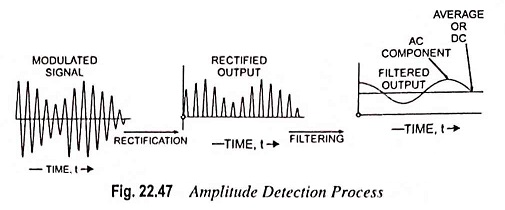Amplitude Detection Process:
Amplitude Detection – The process of demodulation demands that the modulated wave has some definite average value and the carrier wave is separated out. Hence in demodulation of an AM wave two operations, viz. rectification of the modulated wave and elimination of the RF component of the modulated wave are involved.
Essentials of AM Detection:
The modulated wave has both positive and negative peaks of the same amplitude and, therefore, the average value of the wave is zero. Hence it becomes essential to reduce (or better, eliminate) one half of the modulated wave so that the average of the resultant wave is not zero. Either half of the modulated wave can be eliminated by the process of rectification.
After rectification of the modulated wave, the RF portion of the remaining half of the wave is removed by means of a suitable filter so that a signal, that follows the envelope of the rectified signal i.e., the envelope of one half of the wave, is produced. The process is shown in Fig. 22.47.
